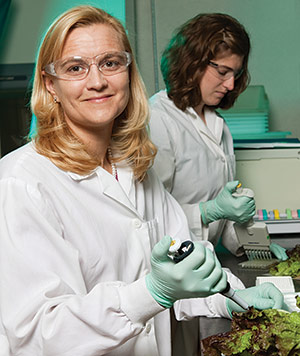
By adam thomasCollege of Agriculture
and Natural Resources

With new regulations for food safety, UD researchers are studying innovative ways to ensure healthy produce and relaying this information to local growers.
These regulations have been implemented with the Food Safety Modernization Act, signed into law in January 2010, giving more power to the U.S. Food and Drug Administration and enhancing the nation's foodborne illness surveillance and tracking capabilities.
The act will impact produce growers and packers by requiring federal audits and checks on safety practices, including environmental testing.
With outbreaks from fresh produce increasing almost 300 percent over the past 11 years, studying leafy greens is especially important to UD professors and students.
"Leafy greens are commonly consumed in their raw state without processing to reduce or eliminate viral and bacterial pathogens," says Kali Kniel, associate professor of animal and food sciences. "Therefore, managing how crops are safely grown and harvested is crucial to minimizing microbial contamination."
She points out that the well-publicized outbreaks associated with leafy greens, combined with the increase in consumption and risk of contamination during growth, make lettuce and spinach excellent plants to study in the laboratory.
Kniel explains that there are two key stages where viral and bacterial contamination to produce can occur.
The first is in the pre-harvest stage, with produce being contaminated from soil, feces, irrigation water, land-applied manures and animals.
The second chance for produce contamination comes in the post-harvest stage, from harvesting equipment, transport containers and humans.
At UD, students and professors are looking at ways to gain a better understanding of the pre- and post-harvest stage of bacterial and viral contamination.
With regard to pre-harvest con-tamination, Jie Wei, a postdoctoral researcher in the Department of Animal and Food Sciences, is studying the survival and transmission of viruses in compost and land-applied manures and biosolids.
Kyle LeStrange, a master's student in the College of Agriculture and Natural Resources, is working on the survival and virulence properties of avian pathogenic E. coli strains in poultry and fresh leafy greens.
Both Wei and LeStrange, in collaboration with Manan Sharma, at the USDA's Agricultural Research Service (ARS) in Beltsville, Md., and Sima Yaron, at Technion University in Israel, are studying how microbial transmission is affected by irrigation methods.
Adrienne Shearer, a research associate in animal and food sciences, is focusing on post-harvest contamination, working on the interaction of norovirus, a non-enveloped virus that causes gastroenteritis, and its survival in bacterial biofilms on stainless steel and on lettuce leaves.
This research will show how norovirus may survive in drains or on kitchen or bathroom surfaces for extensive periods. Finding out how norovirus survives is crucial. The microbe repeatedly has caused disease on cruise ships, even after extensive cleaning, by hiding in biofilms and evading disinfectants.
In her study of pre- and post-harvest contamination, doctoral student Kirsten Hirneisen is investigating whether enteric viruses can enter plant tissue through the root. This research is being done by placing green onions and spinach plants in virus-contaminated soil and virus-contaminated hydroponic systems. After initial contamination, the foods are processed by ultraviolet light or high pressure.
The findings indicate that when grown in the hydroponic systems, both the roots and edible portions of the plants were found to be positive for virus presence, whereas they were not detected in the soil-grown produce, indicating that the current methods of onion and spinach production make it hard for viruses to internalize through the root into the edible tissues of the plant. Processing methods were able to inactivate the pathogens.
With all the new changes that face produce growers around the nation, learning more about the contaminating viruses that plague them is a must.
Kniel said that the new food safety regulations "make it even more important that we understand the science behind microbial survival in the en-vironment and use this information to recommend effective testing and food safety management strategies."
By adam thomasCollege of Agriculture
and Natural Resources

With the increasing concerns about microbial safety of fresh produce, University of Delaware Cooperative Extension specialists and educators are helping local farmers learn about Good Agricultural Practices (GAP) and Good Handling Practices (GHP) through a certification training program geared at teaching farmers how to reduce the risk of produce being contaminated with harmful pathogens.
The four main areas of focus for the GAP training are water safety; manure, compost, and biosolid use; worker hygiene and personal practices; and field sanitation. The GAP/GHP certification training also includes information on training farm workers, third-party audits and developing a food safety plan for the operation.
Concerning manures, the focus is on eliminating runoff from livestock production areas, eliminating contamination by imposing long time intervals between manure application and produce growing periods, and composting manure to reduce or eliminate pathogens. Water safety is another important issue for farmers, particularly those who use ponds or streams for irrigation, which can be contaminated by microorganisms in stormwater runoff. The focus is on regular water testing and treatment systems for surface irrigation water.
On-farm research is being conducted on water safety for produce farms. According to Gordon Johnson, extension specialist and assistant professor of plant and soil sciences, in 2010, a survey was conducted to quantify microbial loading in surface water sources used for irrigation on produce farms throughout the state at bi-weekly periods throughout the growing season. A water treatment system using chlorine tablets also was installed at the irrigation pump on one farm, and the effectiveness of this system for reducing waterborne pathogens will be evaluated in 2011.
Worker hygiene involves simple steps such as hand washing and wearing clean clothes, and field sanitation involves making sure that the tools, equipment and containers used for harvesting and transporting a product are clean and free of pathogens.
In GHP training, the focus is on packing area, sales area and transport sanitation; worker hygiene; and water quality, with regard to the washing of fruits and vegetables.
UD Cooperative Extension agents and specialists have held classes in the three Extension offices in New Castle, Kent and Sussex counties, and they also have traveled to farms to consult with those that required third-party audits, examinations to assist farmers in adopting the best GAP and GHP possible.
Entering the third year of operation, a total of 16 training sessions throughout the state have reached 311 growers and farm workers in Delaware. In total, 156 participants completed the GAP/GHP training and received certification.
The group conducted a six-month post-program survey, and of those who have completed the program, 90 percent of respondents replied that they were better able to manage risks relating to farm food safety, and 95 percent were more apt at understanding their role in preventing food-borne illness.
The GAP/GHP professionals involved in the program include Extension specialists Gordon Johnson, and Sue Snider, professor of animal and food sciences. County-based staff include agricultural agents Phillip Sylvester, Corey Whaley and Tracey Wootten, and family and consumer science educators Maria Pippidis, Kathleen Splane and Ann Camasso.